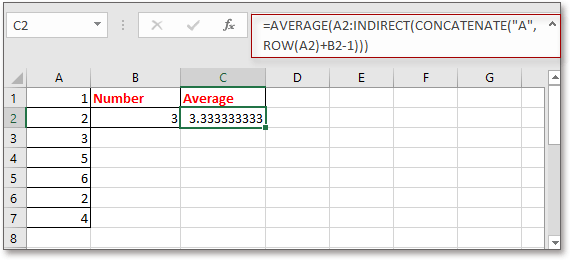Як визначити діапазон на основі іншого значення комірки в Excel?
Розрахувати діапазон значень легко для більшості користувачів Excel, але чи доводилося вам коли-небудь пробувати обчислювати діапазон значень на основі числа в певній комірці? Наприклад, у стовпці A є стовпець значень, і я хочу розрахувати кількість значень у стовпці A, виходячи зі значення в B2, це означає, що якщо це 4 у B2, я буду усереднювати перші 4 значення стовпець A, як показано нижче. Тепер я представляю просту формулу для швидкого визначення діапазону на основі іншого значення комірки в Excel.
Визначте діапазон на основі значення комірки
 Визначте діапазон на основі значення комірки
Визначте діапазон на основі значення комірки
Для обчислення діапазону на основі іншого значення комірки можна скористатися простою формулою.
Виберіть порожню комірку, в якій ви виведете результат, введіть цю формулу = СРЕДНИЙ (А1: НЕПРЯМИЙ (КОНКАТЕНАТ ("А", В2))), і натисніть
Що натомість? Створіть віртуальну версію себе у
ключ, щоб отримати результат.
1. У формулі А1 - це перша клітинка в стовпці, який потрібно обчислити, А - стовпець, для якого ви розраховуєте, В2 - комірка, яку ви обчислюєте. Ви можете змінювати ці посилання, як вам потрібно.
2. Якщо ви хочете зробити підсумок, ви можете скористатися цією формулою = СУММА (A1: НЕПРАВИЙ (КОНКАТЕНАТ ("A", B2))).
3. Якщо перші дані, які ви хочете визначити, не перебувають у першому рядку в Excel, наприклад, у комірці А2, ви можете використовувати формулу наступним чином: = СРЕДНИЙ (A2: НЕПРАВИЙ (КОНКАТЕНАТ ("А", РЯД (A2) + B2-1))).
Швидко підрахувати / підсумувати клітинки за кольором тла або формату в Excel |
| У деяких випадках у вас може бути діапазон комірок з декількома кольорами, і що ви хочете, це підрахувати / підсумувати значення на основі одного кольору, як ви можете швидко обчислити? з Kutools для Excel's Підрахувати за кольором, ви можете швидко зробити багато розрахунків за кольором, а також можете створити звіт про обчислений результат. Натисніть, щоб отримати безкоштовну повнофункціональну пробну версію за 30 днів! |
 |
| Kutools для Excel: із понад 300 зручними надбудовами Excel, які можна безкоштовно спробувати без обмежень протягом 30 днів. |
Найкращі інструменти продуктивності офісу
Покращуйте свої навички Excel за допомогою Kutools для Excel і відчуйте ефективність, як ніколи раніше. Kutools для Excel пропонує понад 300 додаткових функцій для підвищення продуктивності та економії часу. Натисніть тут, щоб отримати функцію, яка вам найбільше потрібна...

Вкладка Office Передає інтерфейс із вкладками в Office і значно полегшує вашу роботу
- Увімкніть редагування та читання на вкладках у Word, Excel, PowerPoint, Publisher, Access, Visio та Project.
- Відкривайте та створюйте кілька документів на нових вкладках того самого вікна, а не в нових вікнах.
- Збільшує вашу продуктивність на 50% та зменшує сотні клацань миші для вас щодня!
